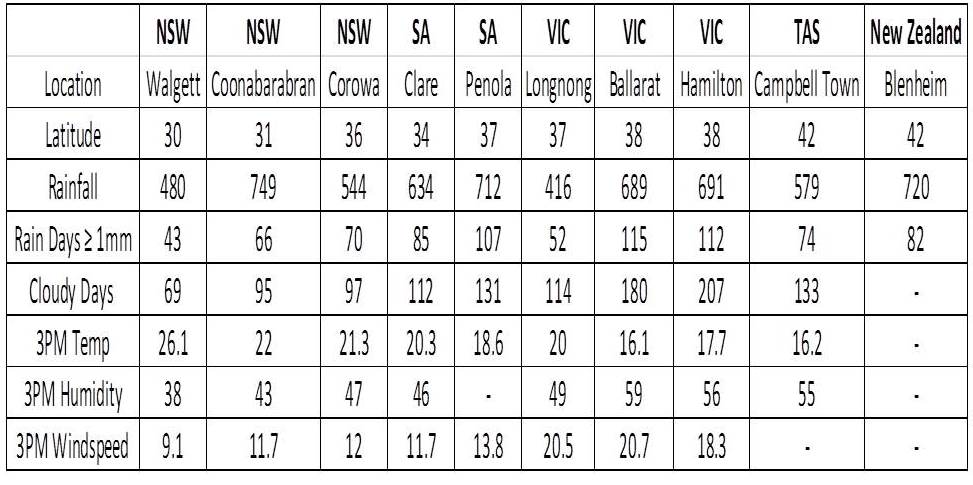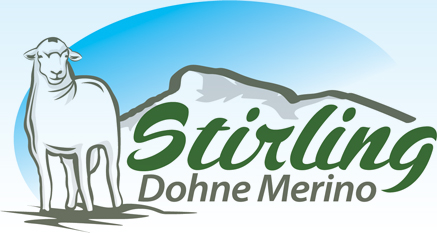As a child before the advent of thibenzole sheep drench I remember both parents dagging sheep until well after 10PM completely enclosed by an 8 feet high edifice, stretching perhaps 20 feet to the horizon.
Before this time at about 4 or 5 years I recall standing in the backdoor of my grandparents woolshed, gazing in wonder at the small mountain of toenail trimmings, perhaps 12 feet high. With a few short years and a little experience I was able to exchange the word “wonder” with “horror.”
Years have passed since this “magic” cure for excess toenail growth has disappeared. Todays labour passion and cost governs the modern pathway.
Table 1. Annual Climate Averages at Various Australian Locations.

The standout figure in this table is the number of cloudy days at Hamilton at 207 followed by Ballarat at 180 and Campbell Town at 133.
This micro-climate in the South-West is formed by 3 features, its proximity to the Bass Strait, protection from the hot interior continental conditions by the Grampian Ranges and the moisture-laden westerly from the South American continent.
These conditions allow the heavy stocking rates which have earned it the sheep capital status but have also supplied the damp protein-rich pastures which have challenged the species feet.
LIFETIME OBSERVATIONS
The Aboriginal tribal name for the people occupying the Eastern Grampian fold down to Penshurst Caramut and Lake Bolac, was Djab wurrung or “soft-lipped” people.
Human nail growth increases rapidly under high humidity.
Large intermittent rain dumps or summer rainfall express faster growing grass with higher fibre content whilst showery cloudy weather or winter rainfall produces a protein tip and more legume which upon palatability accentuates scald infection.
Short straight pasterns assist in a thicker heal and more even wear whilst a little toe spread decreases sweating and lower bodyweight decreases the incidence of abscess.
Of the many Merino strains I have tried the 2 oldest measured. ‘Dohne” and “Hazeldean” have by far the highest toenail growth rate. Both originated at 33 to 36 Latitude, in high altitude 530mm to 600mm rainfall country, running on undulating rocky terrain under high fibre grass production.
In 2011 I used Lincoln University (NZ) footrot test and will revisit again this year but am still convinced with the Charles Darwin natural selection method. The measurement however may be valuable for ram consumer selection if accuracy includes both nail growth and infection immunity.
I have used blocks, medicated water reticulation, dry powered licks and copper, zinc and sulphate fertilizers variously over the last 40 years without diminishing the problem. New formulation Zinc Methionine is used at present with organic Iodide on the list.
Covered hay or straw in racks during high protein Autumn-Winter growth can assist in controlling scald and poly hay caps fitted tightly around the racks and strategically prinkled with Zinc Sulphate is a good labour-saving device.

THE CAUSE
The South-West Victorian micro-climate’s damp conditions both increase the growth and decrease the wear of side-wall horn and toe horn and predispose conditions suitable for infection spread.
Increased side-wall horn length levers separation from the sole horn allowing dirt and germ entry which further levers the opening. ( Shelley hoof.)
Scald and other milder infections quickly develop and if left unchecked, benign and malignant footrot follow with appropriate strain availability.
THE CURE
Challenge and select for slow horn growth and infection immunity.
Get foot structure right but be aware that it is not the primary cause.
Acclimatize the Dohne high-fibre origins to the new damp high protein-tip climate and only introduce new genetics from similar climates.
THE CHALLENGE
- Mature stud sheep needing trimming are culled
- Mature stud sheep are foot-bathed only during emergencies
- Mature stud sheep are long grass run with cattle.
- A whole stud grain ban since 2009 forces sheep onto wet grass.
